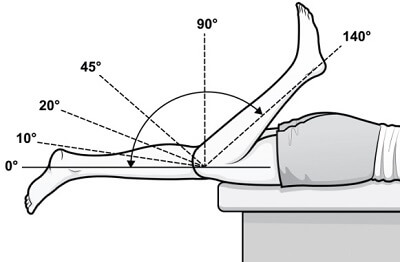Treating for Better Flexibility and Range of Motion in the Lower Extremities
Last month, Jaffe Sports Medicine informed blog readers about optimal range of motion (ROM) of the upper extremities. Part two of this series will discuss the lower extremities and what you can do when optimal motion cannot be achieved.
Anytime you experience pain with motion or loss of movement that worsens over time, these are both signs that there may be something more serious going on within the joint.
Remember, there is always a reasonable concern when our bodies are not moving the way they should. Let us look again at the proper range of motion guides to help in understanding more about where your motion is limited.
Lower Extremities
The lower extremities consist of your hips, knees, and ankles. Decreased motion can occur after an injury, a fall, impact sports, working out, or wear and tear on your joints from repetitive motions over time.
Obesity can also play a part in the decreased motion of the lower extremities—considering that all your weight is resting on your hips, knees, and ankles, which are weight-bearing joints. Excess weight will always affect these weight-bearing joints.
One indicator that ROM is compromised in the lower extremities is an altered gait or the stride you walk. To determine if your gait is altered, your doctor will analyze your gait to look for irregularities. Observation may indicate:
- A nerve or muscle problem that is causing a limp.
- An ataxic gait, which is characterized by poor balance, unsteady or weakened stride, or veering.
- A dropped foot due to weakened muscles in the ankle joint.
Hips
Have you ever noticed that there is a stiffness in your hips after sitting for a long period? The stiffness will typically go away after taking steps forward; however, you may notice a pronounced “waddle” in those first few steps.
For some patients, an affected gait may be one of the first symptoms that hip strength and motion are on the decline.
The hip’s range of motion is produced by the hip joint–the ball and socket that join the pelvis and femur.
This ball and socket fit together to produce the fluid motion that allows the legs and torso to move. Good ROM in the hips is measured in degrees as in the graphic below:

Evaluations look at passive motions, which is how much you can move your ship around the joint with the assistance of a healthcare professional. Active range of motion also evaluates motion but puts the patient in control of the motion.
If ROM is affected, we will take an X-ray, CT, or MRI of the joint to determine deterioration, joint disease, infection, or a fracture. If there appear to be none of these problems affecting motion, we will recommend conservative treatments like at-home stretching, physical therapy, steroid injection, or other pain management options.
Suppose you are looking at just a mild stiffness in the hips rising from a seated position. In that case, we often recommend hip flexors to strengthen the joint and increase the ability to produce better motion in the hip.
Knees
Our knees are the ultimate bearers of all weight. The knees are the most injured joint of all sports-related injuries. Outside of sports, our knees can be injured through a fall, obesity, misstep, or strain while walking on uneven terrain or stairs or overextending while performing daily tasks.
Good ROM in the knees is needed for balancing and support. Good rotation is necessary for stability while the legs are in motion. ROM that is normal looks like this:

Again, your doctor will look for passive-active ROM to determine if motion has been compromised. Additional testing may be needed to determine the extent of any cartilage, joint, or patellofemoral damage. There are successful treatments for regaining good motion in the knees that JSM can recommend depending on the extent of your loss of motion.
Ankles
The ligaments, tendons, and bones of the ankles can become injured quite extensively. There are simple sprains and strains, tendonitis, and much more in-depth injuries such as a fracture or torn ligaments. Good ROM in the ankle will appear as in the graphic below:

Dorsiflex is raising the foot, and plantar flexion is pointing down with the foot.
Limited ROM can have additional symptoms that include swelling, throbbing, sharp pain, intermittent pain outside or inside of the ankle area, and bruising.
Again, the ankle is a weight-bearing joint and can easily become injured or strained by falling, rolling, or overstepping, balance problems, jumping, and other impact sports.
A good range of motion benefits includes decreased pain, better flexibility, strength, better blood flow, more vigorous movements, and bodily actions, and lower potential for injury.
Treatment Options
If you are experiencing pain that prevents good movement of any joint, we consider you to have a limited range of motion.
Jaffe Sports Medicine understands a good range of motion includes decreased pain, better flexibility, strength, better blood flow, more vital movements and bodily actions, and lower potential for injury. We work individually with each patient to ensure that their health and wellness goals are met. We focus on all aspects of the body, including alignment, movement, and postural habits.
With a blend of physical therapy, interventional pain management, and additional sports medicine strategies, we will help you protect your body and prevent further injury.
At Jaffe Sports Medicine and Rehabilitation, we help our patients recover quickly, regain strength, and improve their range of motion while avoiding painful, expensive surgery. To schedule an appointment at one of our locations, contact Jaffe Sports Medicine today.
TEXT BY M. HIATT
